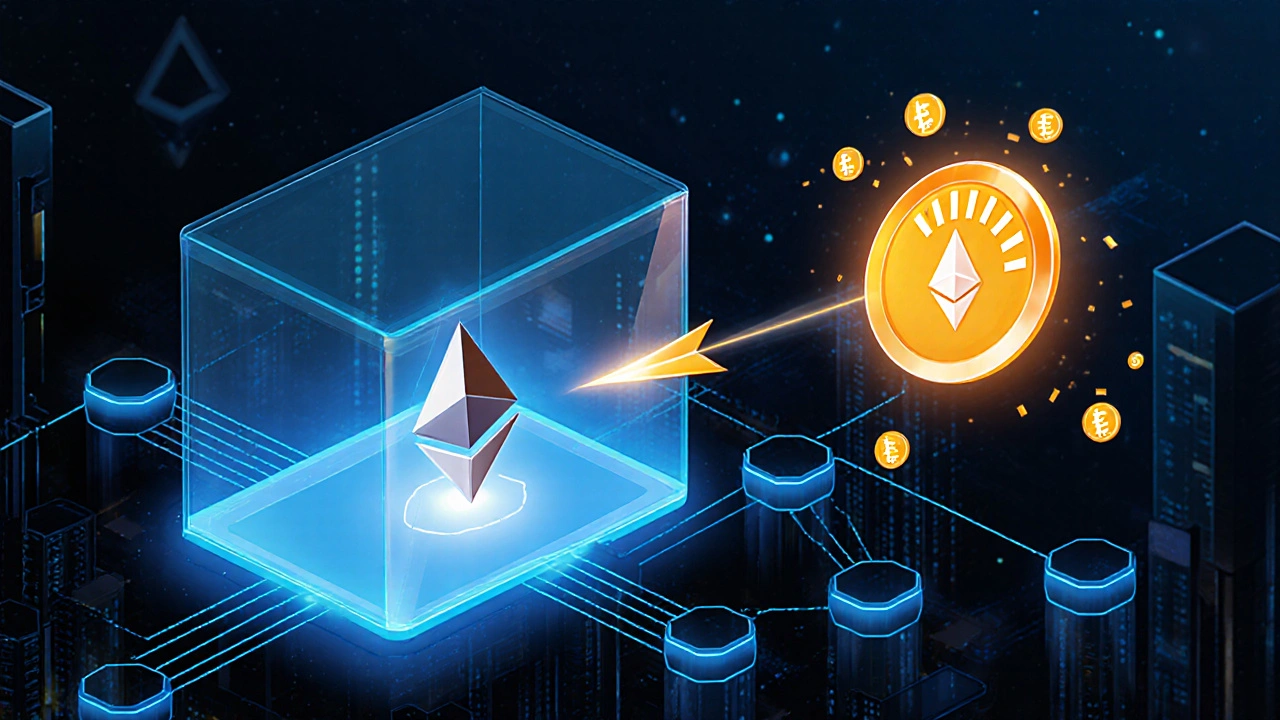When you send a transaction on Ethereum, a decentralized platform that runs smart contracts and dApps, you need to pay a gas fee. That fee isn’t a tax - it’s the amount of computational work your transaction consumes, and it’s paid in Ether, the native cryptocurrency of the network. If you’ve ever wondered why the cost of sending a simple transfer can sometimes be higher than buying a coffee, you’re in the right place.
Key Takeaways
- Gas is the unit that measures how much work a transaction or smart‑contract call requires.
- Before August 2021, fees were calculated as gas limit × gas price. After EIP‑1559, they are base fee + priority fee (tip) per gas unit.
- Network congestion, transaction complexity, and the chosen fee model all affect the total cost.
- Tools like gas trackers and layer‑2 solutions can help you keep costs down.
- Understanding the fee structure lets you avoid overpaying and lets your dApps stay affordable.
What is a gas fee?
In the Ethereum ecosystem, gas quantifies the computational effort required to execute operations. Every operation - from a simple ETH transfer to a complex DeFi trade - consumes a certain amount of gas. The network charges you for this gas in Ether. Think of gas as the fuel that powers your transaction; the fee you pay is how much that fuel costs at the moment you submit the transaction.
How gas works on Ethereum
When you create a transaction, you specify two key numbers:
- Gas limit - the maximum amount of gas you’re willing to let the transaction consume. If the operation runs out of gas, it aborts and you still pay for the gas used up to that point.
- Gas price - how many gwei (one‑billionth of an Ether) you’re willing to pay per unit of gas.
The total fee (pre‑EIP‑1559) was simply gas limit × gas price. Miners prioritized transactions offering higher gas prices because they earned more from each block they sealed.

EIP‑1559 and the new fee model
In August 2021, Ethereum rolled out EIP‑1559, a major upgrade that changed how fees are calculated. Instead of a single gas price, the network now splits fees into:
- Base fee - a protocol‑determined amount that adjusts every block based on how full the previous block was. The base fee is burned (removed from circulation), reducing overall ETH supply.
- Priority fee (tip) - an optional amount you can add to incentivize validators (previously miners) to include your transaction quickly.
The new formula is gas used × (base fee + priority fee). This mechanism stabilizes fees, makes them more predictable, and removes the “fee market” spikes that once made gas wildly expensive during network congestion.
Factors that affect your gas cost
Even with EIP‑1559, several variables still influence how much you’ll pay:
- Transaction complexity - Simple ETH transfers use about 21,000 gas units. Interacting with a smart contract can consume anywhere from 50,000 to several hundred thousand units, depending on the logic involved.
- Network congestion - When many users compete for block space, the base fee rises. During popular NFT drops or DeFi launches, base fees can skyrocket.
- Priority fee (tip) - Adding a higher tip speeds up inclusion, but it also raises the total cost. Most wallets set a default tip of 1-2 gwei, which is usually sufficient.
- Gas limit set by the user - Over‑estimating the limit means you lock up more ETH temporarily (though unused gas is refunded). Under‑estimating can cause the transaction to fail.
How to estimate gas before sending
Most wallets and dApps automatically estimate the gas limit and suggest a priority fee, but you can manually check using a few reliable tools:
- Ethereum gas trackers like etherscan.io/gastracker or gasnow.org display the current base fee and recommended tip levels.
- Simulation APIs (e.g., Infura or Alchemy) let you run a transaction locally to see exactly how much gas it would consume.
- Wallet calculators - MetaMask’s “Edit” button on the gas fee dialog shows a sliding scale from “slow” to “fast” with corresponding cost estimates.
To calculate the fee yourself, plug the numbers into the formula:
total fee (ETH) = gas used × (base fee + priority fee) ÷ 1,000,000,000
For example, a swap that uses 120,000 gas when the base fee is 30 gwei and you set a 2 gwei tip would cost:
120,000 × (30 + 2) = 3,840,000 gwei = 0.00384 ETH
At a market price of $1,800 per ETH, that’s roughly $6.91.
Tips to keep gas fees low
- Batch transactions - If you need to send multiple payments, combine them into a single smart‑contract call whenever possible.
- Use layer‑2 solutions - Networks like Arbitrum, Optimism, and Polygon settle transactions off‑chain and then post a single proof to Ethereum, cutting fees by 90% or more.
- Time your transactions - Gas fees dip during weekends and early UTC hours when fewer users are active.
- Set an appropriate tip - For non‑urgent actions, a 1 gwei tip is often enough after the base fee has been burned.
- Watch for fee‑saving upgrades - Future releases like Ethereum’s “sharding” roadmap aim to increase throughput, which should bring fees down dramatically.
Common pitfalls and misconceptions
"Gas fees are a tax" - They’re not a government-imposed levy. Fees reward validators for securing the network and preventing spam.
"Higher gas price always = faster confirmation" - After EIP‑1559, the base fee determines the minimum price. Adding an excessively high tip won’t make a transaction confirm instantly if the block is already full.
"If my transaction fails, I lose all the ETH I sent" - Only the gas used before the failure is burned. The principal amount you tried to send remains in your wallet.
"All ETH used for gas disappears forever" - Pre‑EIP‑1559, miners kept the fee. Post‑EIP‑1559, the base fee is burned, while the tip goes to validators. The burning mechanism reduces total supply over time.
| Aspect | Pre‑EIP‑1559 | Post‑EIP‑1559 |
|---|---|---|
| Fee calculation | gas limit × gas price | gas used × (base fee + priority fee) |
| Fee destination | Paid to miners | Base fee burned, tip paid to validators |
| Fee volatility | Highly volatile, market‑driven | Base fee auto‑adjusts per block, more predictable |
| User control | Set any gas price | Can set tip; base fee is mandatory |
| Impact on ETH supply | None (fees minted) | Burning reduces supply |
Final thoughts
Understanding Ethereum gas fees helps you avoid surprise costs and design smarter dApps. By watching the base fee, setting sensible tips, and leveraging layer‑2 solutions, you can keep expenses low while still enjoying the security of the Ethereum network.
What exactly does the term “gas” mean on Ethereum?
Gas is a unit that measures the amount of computational work required to execute operations on the Ethereum blockchain. Every opcode in a smart contract or transaction consumes a certain amount of gas, and you pay for that gas in Ether.
How does EIP‑1559 change the way I pay for gas?
EIP‑1559 splits the fee into a mandatory base fee (which is burned) and an optional priority fee (tip) for validators. You no longer set a single gas price; instead, you set the tip you’re willing to pay on top of the automatically adjusted base fee.
Why do gas fees sometimes spike to hundreds of dollars?
Spikes happen when the network is congested-usually during popular NFT drops, DeFi launches, or market turbulence. The base fee rises to prioritize the most valuable transactions, leading to higher overall costs.
Can I get a refund if my transaction fails?
You only lose the gas that was actually consumed before the failure. The principal amount you intended to send is returned to your wallet.
What are the best ways to reduce my gas costs?
Use layer‑2 solutions (Arbitrum, Optimism, Polygon), batch multiple actions in one transaction, schedule transfers during off‑peak hours, and set a modest tip. Monitoring gas trackers also helps you pick the cheapest moment.


Understanding Ethereum gas fees can feel like learning a new language, but once you break it down the pieces start to fit together like a well‑designed smart contract. The term “gas” itself is a metaphor for fuel, representing the computational work required by the network to process any action you initiate. Every opcode that a contract executes consumes a specific amount of gas, and the total gas used is multiplied by a price to determine the fee you pay in Ether. Before the introduction of EIP‑1559, users manually set a gas price in gwei, hoping to outbid competing transactions for inclusion in the next block. This created a market‑driven dynamic where miners would prioritize the highest‑paying transactions, often leading to spikes in cost during periods of heavy demand. With EIP‑1559, the fee model was split into a base fee that adjusts automatically each block and a priority fee, or tip, that users can add to incentivize faster processing. The base fee is burned, removing that amount of Ether from circulation, which in turn has a subtle deflationary effect on the overall supply. Because the base fee is algorithmically determined by how full the previous block was, it tends to smooth out extreme volatility, though it can still rise sharply when the network is congested. The priority fee remains optional, and most wallets set a modest default that is sufficient for non‑urgent transactions. When you send a simple ETH transfer, the gas limit is typically 21,000 units, but interacting with complex DeFi protocols can require anywhere from 50,000 up to several hundred thousand gas units. It is essential to set your gas limit high enough to cover the execution; otherwise, the transaction will run out of gas and revert, still costing you the gas used up to that point. Many wallets now provide automatic estimations, but power users can simulate transactions with services like Infura or Alchemy to see exact gas consumption before broadcasting. Layer‑2 solutions such as Arbitrum, Optimism, and Polygon move the heavy lifting off‑chain and then post succinct proofs back to Ethereum, slashing fees by up to 90 percent. Timing your transactions for off‑peak hours-often during weekends or early UTC mornings-can also reduce the base fee you pay. Finally, keep an eye on gas trackers like Etherscan’s Gas Tracker to monitor real‑time fee levels and adjust your tip accordingly. By mastering these concepts you can avoid overpaying, keep your dApps affordable, and contribute to a healthier Ethereum ecosystem.
Oh, look at us, finally figuring out that gas isn’t a mysterious tax-who would’ve thought?!!! You just set a gas limit and a price and hope the validators don’t roll their eyes. Also, the whole EIP‑1559 thing? It’s basically the network saying “I’ll handle my own pricing, thanks!” and you just tip if you’re in a hurry… or not…
It is imperative to recognize that the transition to EIP‑1559 was not merely a technical upgrade but a strategic maneuver orchestrated by a cohort of vested interests within the mining community. By instituting a base fee that is burned, the protocol ostensibly aligns miners’ incentives with network stability, yet the concomitant tip mechanism perpetuates a subtle hierarchy of transaction prioritization. Moreover, the deterministic nature of the base fee adjustment algorithm introduces a predictable pattern that, if exploited, could enable sophisticated arbitrage schemes. One must also consider the broader macro‑economic ramifications, wherein the systematic reduction of Ether supply through burning may engender inflationary pressures on derivative assets. In sum, while the user‑facing experience appears streamlined, the underlying dynamics remain fraught with complexity and potential manipulation.